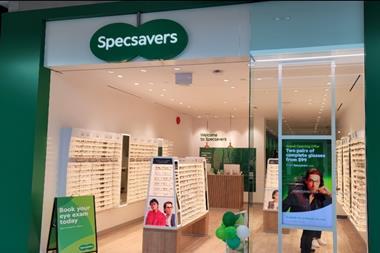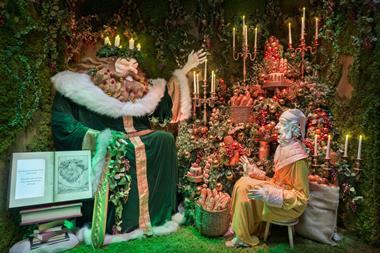This year’s festive countdown is arguably going to be more nail-biting than ever. Charlotte Hardie considers how retailers can make the most of what might be the toughest Christmas for decades
While shoppers’ thoughts are consumed with holidays, summer wardrobes and trying to plan their barbecues around sporadic thunderstorms, all retail attention is very much focused on the most important time of year – Christmas.
With fewer than 150 days left until the big day, what are the early predictions for consumer spending now that the recession is well under way, and how will retailers try to maximise their
festive fortunes?
Unsurprisingly, most agree it will be another difficult Christmas. Verdict consulting director Neil Saunders says that overall it will be a “very muted affair”. Deloitte head of retail Tarlok Teji agrees: “The second half of the year will be reasonably tough compared with the first half.”
Meanwhile, Capital Economics analyst Vicky Redwood goes one step further. “This Christmas could definitely be a tipping point in terms of things taking a turn for the worse for retailers,” she says. Why? Despite talk of the economy bottoming out and the worse being behind us, there is widespread uncertainty. Teji says: “Generally, consumers will be cautious because it’s unclear from the economic indicators whether the economy is in recovery or not.”
There is also concern about the consumer mindset amid predictions about rising unemployment levels and pay cuts. PricewaterhouseCoopers partner Olivia Gillan says: “Even though many people who are still employed are slightly better off because of low interest rates and so on, with all the talk about redundancies there is that sense that it could be you.” Furthermore, she adds, people are saving far more than they have for years.
Despite this, John Lewis director of selling operations Nat Wakely is, at this stage, quietly optimistic that this Christmas will be an improvement on the previous year’s – although he adds that this still equates to being about 10 per cent below where it was for Christmas 2007. “I’m hopeful that from October onwards we will start to move into positive territory.” This is largely because, for the past few months, the retailer has gradually seen upwards sales lifts on a month- by-month basis. Wakely adds that his prediction is, of course, based on the assumption that the chances of economic recovery are not hit by any further setbacks.
Christmas wish list
Despite the odd glimmer of optimism, all retailers are more than aware that they need to be on their guard. Redwood warns businesses not to be lulled into a false sense of security by the relative resilience of retail sales in the past few months. “There might be optimism this year because of talk of the recession ending, but that could end up disappointing.”
Another factor that could well negatively affect this year’s festive season is discounting. Last year, as early as November, the high street was awash with Sale signs, email inboxes were clogged with friends and family discount offers, and discount days lured shoppers through shop doors in their droves. Marks & Spencer went head to head with Debenhams and ran a 20 per cent discounting day – its biggest Christmas promotion for years.
Saunders predicts this trend will be repeated. “We’ve already seen a lot of that this year so far. It will ease off over late summer and early autumn but by Christmas everyone will be in such a mad rush to get shoppers through their doors – it only takes one to go down that route and everyone else follows.” But because prices will be cheaper, sales growth will be restricted and while Teji thinks such promotions are inevitable, he urges all retailers to try and restrain themselves. “Such discounting is a shame because they’re giving away margin. People will be spending but retailers have a tendency to get too competitive, too early.”
What is certain is that retailers will need to work even harder than usual to maximise sales in what everyone expects will be a tough few weeks.
One factor that all retailers should prepare for is the effect of the VAT increase that is scheduled slap bang in the middle of the Sales period on December 31. It may not make much difference to individual purchases, but even 2.5 per cent on a family’s collective Sale shop adds up, and at a time when everyone is trying to save maximum money it may well prompt shoppers to do as much of their Sale shopping before New Year’s Eve instead of waiting until the New Year.
Firstly, retailers need to consider the potential ramifications on store operations. Will the prospect of a VAT increase prompt an even greater stampede than usual on Boxing Day? Will security and staffing levels be sufficient to cope?
While this is difficult to predict, Gillan points out that some retailers will be able to use the VAT increase as a footfall driver in the run-up to Christmas. She points out that when the VAT rate increased in Germany there was a big shift in spend – particularly for the big-ticket items, and people made sure they did their shopping before the increase. She says: “We could see retailers playing on that.”
Comet commercial director Bob Darke says that while the timing of the VAT increase is “not the most sensible”, the electricals retailer is hoping it will help drive footfall for its early pre-New Year Sale, and is ready to react with a plan of action depending on the specific Government instruction that is due to be issued.
If, through clever marketing of the VAT changes, retailers can persuade shoppers to part with their money earlier, it will also help them shift their autumn/winter 2009 stock earlier, thus potentially reducing the necessity for even deeper discounting as the New Year trade progresses.
And, of course, while money is tight, people will still spend. The responsibility now lies with the retailer to come up with inventive ways of making them do that. Darke says: “How we bring the product to customers will be key. Retailers will need to be cleverer and we all need to find new ways of making it look and feel exciting for the shopper.”
Saunders says: “People will be splashing out but in different ways. To get people to spend, retailers need to make it interesting. Consumers have had an awful year. People are fed up of being fed up.” Darke agrees: “People want to be positive and the mindset that’s still around is there will be an element of treating themselves just to keep everyone sane.”
Within the four walls of retail head offices, a flurry of festive planning is taking place. Predicting how those vital few weeks will pan out is always nerve-wracking, but one thing’s for certain – be it around marketing, pricing, promotions or products – creativity will separate the winners and the losers.
Product trends
What recessionary trends are retailers’ hopes resting on this Yuletide?
“Retailers really will need compelling products this year,” warns Verdict consulting director Neil Saunders. Of course, from a buyer’s perspective, the deed has already been done – the stock upon which retailers’ festive hopes are pinned is already winging its way to the UK from far-flung corners of the world. So what types of product are predicted to fly off the shelves?
Saunders predicts this year that “fripperies” – the cheap and cheerful stocking fillers – will be shunned. “These have always been popular in the past, but last year there was a lot of this type of product left on the shelves. Consumers will be more frugal than that.” They will want to buy products that they know won’t be shoved to the bottom of the drawer.
This year, the price has to be right for shoppers to buy. Argos has increased the number of its value range products in its catalogue by a third this year, having added another 300 lines. Argos commercial director Steve Knights says: “Importantly, we have wide choice of price points – whether that’s a camera for £25 or £800,” he says. “Whatever customers are buying at whatever price point, we offer great value.” That message is played out in its marketing material, which features straplines such as “Helping you live for less”, and lists ranges that are described and grouped as “cut back kitchen”, “credit crunch corner” or “luxury for less”.
Fashion retailers are also expecting shoppers’ new-found thriftiness and their pared-down approach to be reflected in clothing sales. Karen Millen creative director Gemma Metheringham says the fashion retailer has noticed that its customers are investing in occasion and party wear pieces that are more versatile. “I think there is a move away from the excessive and the ostentatious throughout the season. In our shoots we’ve styled the sparkly dresses and tops with leather jackets for a more understated going out look.”
Another major product trend this year will be an increase in sales of practical kitchen gadgets and equipment such as bread makers, sewing machines and slow cookers. Comet commercial director Bob Darke says: “Before, Comet had almost stopped using any phraseology about getting your home ready for Christmas because it conjured up images of 1950s housewives, but now we’re seeing a return to that. This year, it’s maybe a little less flashy than in the past. There’s a sense of making do,” he says.
And now that shoppers are eating out less, John Lewis director of selling operations Nat Wakely says the retailer is also expecting sales of products linked to home entertaining and dinner parties to remain buoyant – be that candles, table cloths or chocolates. “This has been growing for the past 10 months or so and we anticipate that will continue,” he says. Because people are spending more time at home, Knights says Argos is also predicting that this will help lift sales of home entertainment goods such as TVs, mp3 players and video games.
Cashing in on nostalgia
But perhaps most noticeable this year is shoppers’ desire for nostalgia and tradition. As John Lewis buyer for seasonal events Charlotte Archer says: “The signature theme for 2009 has been inspired by the feel of coming home.” It has, for instance, a vintage-themed set of Christmas decorations this year, which Archer says evokes “warm nostalgic feelings and memories”.
Wakely adds: “Traditional gifting will play a big part. When you go into a downturn you want to look to things that make you feel more comfortable.” Knights agrees: “It will be a very traditional Christmas that is about traditional family values.”
With shoppers monitoring their festive spend closely, the well-known toy brands associated with durability will be the strong sellers – from Lego to Barbie to Action Man to the Rubik’s cube. The 1980s classic Transformers will also be making a comeback following the film release this year.
In January, Argos bought the former- Woolworths-owned Chad Valley toy brand for £5m. If predictions about the trend for traditional toys turns out to be true, it will have been £5m well spent. As Knights says: “It’s a brand that consumers associate with heritage.” Among the 100 Chad Valley toys in the Argos catalogue this year are old-fashioned products such as a wooden dolls house and a garage play set.
There is all to play for over the next five months. So while buyers and creative teams remain on tenterhooks to see whether their carefully chosen or designed ranges meet consumers’
expectations, it’s now down to their colleagues to think both strategically and imaginatively about how they’re going to shift them.


























No comments yet